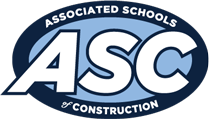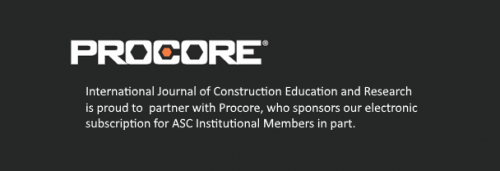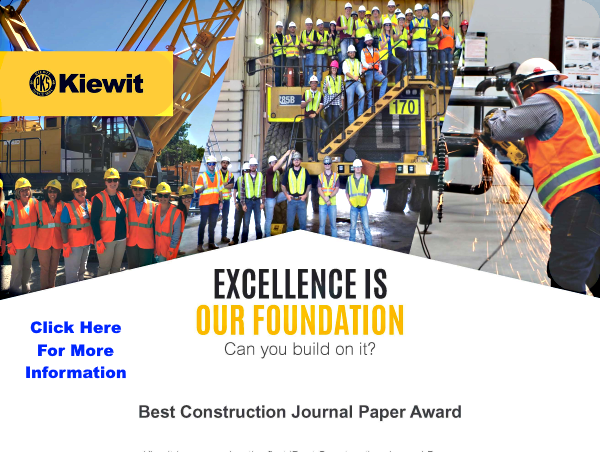International Journal of Construction Education and Research
Author Instructions for Submitting
Submitting an article to the Journal implies the manuscript is original and is not being considered nor has been published in whole or in part within another journal. Papers that have been published within conference proceedings (such as ASC’s annual International Conference proceedings) may be considered if the author makes significant changes to the document OR it has been recognized as a quality conference paper by conference coordinators, editorial offices, best paper, etc. The Journal would footnote that the paper has been previously published and presented at a conference. Manuscripts accepted for publication will require authors to sign the Taylor & Francis Assignment of Copyright Agreement. Authors whose manuscripts have been accepted for publication will be contacted by Taylor & Francis regarding the copyright agreement.
Authors should prepare manuscripts according to the ASC’s Publication Style Guide, which conforms to the Publication Manual of the American Psychological Association (5th ed). All manuscripts must include an abstract, which is limited to one paragraph, containing a maximum of 200 words. Immediately following the abstract, a maximum of five key words or phrases must be included. Instructions addressing composition of manuscripts, including headings, paragraphs, text body citations, tables, figures, references, appendices, and abstracts appear in the ASC’s Publication Style Guide. All manuscripts are subject to editing for personal, university, program and sexist language. Manuscript length should be related to the information value of the manuscript.
The editors of the Journal consider it unethical for authors to withhold the data on which their conclusions are based from other competent professionals who seek to verify the substantive claims through reanalysis and who intend to use such data only for that purpose, provided that the confidentiality of the participants can be protected and unless the legal rights concerning proprietary data preclude their release. Authors submitting to the Journal are expected to have their research data available throughout the editorial review process and for at least five years after the date of publication.
Manuscripts must be submitted electronically via the Journal’s ScholarOne website located at http://mc.manuscriptcentral.com/uice. Instruction for submission can be accessed at the ScholarOne website or through the following link: (IJCER_Instructions_to_Authors.pdf) By submitting a manuscript for possible publication in the Journal, authors grant permission to the editorial board to follow the review process outlined below.
First, all manuscripts submitted to the Journal will be reviewed by a member of the Editorial Office for appropriate content, composition, etc. Second, manuscripts approved for peer review will then be submitted to two other peer reviewers, one of which will include a member of the Journal’s Editorial Board of Reviewers, who are qualified in the content area to determine whether or not the research will be accepted for publication in the Journal. Manuscripts will be transmitted to reviewers electronically, and any correspondence between authors and editors will also be processed in this manner.
Author(s) should carefully review the following submission instructions:
- Copyright and Permissions
- Style Guide
- Formatting Instructions
- Review Process
Manuscripts submitted to the Journal should be finished products and will be accepted or rejected for publication in the Journal based on a majority decision of peer reviewers. Comments to authors submitting to the Journal will be summarized only after a final decision is made by reviewers. Articles submitted to the Journal should not be considered a-work-in-process.
If you have any questions, please contact the editorial staff at asc.journal@byu.edu or asc-ijcer@colostate.edu.
Copyright and Permissions
By submitting manuscripts to the International Journal of Construction Education and Research authors imply the manuscript is original and is not being considered nor has been published in whole or in part within another journal. If papers have been submitted, reviewed, presented and/or published within a Conference Proceedings, they may be considered a “work‑in‑progress;” however, it is expected that manuscripts submitted to the Journal will reflect significant changes resulting from that presentation process in order to be considered for publication in the Journal.
The copyright for this International Journal of Construction Education and Research is owned by Taylor & Francis. Authors may be allowed to reuse their own materials by requesting permission to do so through the Taylor & Francis online permissions form. Persons seeking such permission should note that he/she is the author of the work for which permission is being sought. There is no cost associated with this request.
Style Guide
The publication style for the International Journal of Construction Education and Research conforms closely to the recommendations of the Publication Manual of the American Psychological Association, Fifth Edition. All manuscripts must be in this style before being sent out for review. Authors should follow the style guide carefully before submitting a manuscript to the Journal.
Style Guide for the
- International Journal of Construction Education and Research, (IJCER Publication Style Guide)
- Publication Manual of the American Psychological Association, Fifth Edition
Formatting Instructions
Manuscripts must be complete and must follow the Style Guide for the International Journal of Construction Education and Research for consideration. Preferred file formats for manuscript submittal include: WordPerfect or MS Word
- Tables All tables must be created using the table function within the same word processing system as the manuscript. No table may be included as an image file or inserted as a reference to another file document (i.e. Excel, Access).
- Figures Graphs, photographs, artwork, and illustrations should be drawn using a suitable drawing package, and embedded within a separate figures file following the Style Guide instructions. Black and white images are strongly encouraged. Only .gif and .jpg file formats are considered acceptable. Submitted images should adhere to the resolution setting of 300 dpi.
- References All citations in the manuscript must be supported by a reference listing. All references listed must be cited within the main body of text..
- Appendixes A detailed description of certain material that by its inclusion in the body would prove to be detracting. Information submitted in an appendix must be necessary for clarification of the article’s content.
If the manuscript does not meet professional standards determined by the Editorial Board of the Journal, it will not be published. It is the authors’ responsibility to very carefully check any symbols, abbreviations, and technical terms for accuracy, consistency, and readability and to ensure that manuscripts and illustrations meet the Journal’s format publication requirements.
Review Process
Manuscripts being submitted for review by the Journal’s Board of Reviewers must be submitted via the ScholarOne website as described above. Following a blind review by the Editorial Office, appropriate manuscripts submitted by authors will be circulated to review board members via ScholarOne. All correspondence with the authors, editors, and review board members will also be completed electronically. Members of the Editorial Staff (editor in chief, managing editor, and associate editors) are responsible for managing the review process.
Educational practice and research manuscripts that appear in the Journal will have been blind reviewed by a minimum of three members of the Journal’s Board of Reviewers, or area experts as determined by the Editorial Board. All manuscripts, whether invited or unsolicited, will be critically reviewed. Manuscripts must demonstrate clear communication and authority of knowledge of the topic to ensure acceptance. Reviewers will be selected from those peers having content knowledge concerning the manuscript’s topic. Authors are notified upon receipt of manuscript and completion of the review process. Additional communication will be at the discretion of the Editorial Board.
Case Studies
We encourage submission of case study manuscripts that involve unique insight into or advances in construction. Involvement of industry representatives in the preparation of these manuscripts is encouraged. Thorough literature review should be undertaken to determine and validate the uniqueness of the case study being submitted to this Journal. Authors preparing to submit this and other forms of manuscript should keep in mind the ASC mission to develop and advance construction education, “where the sharing of ideas and knowledge inspires, guides and promotes excellence in curricula, teaching, research and service.”
Technical Research Manuscripts
This division of the Journal provides for the reporting of scholarly work on new or unique academic and educational programs, curricula and courses, innovative instructional processes, and instructional work undertaken in the field related to construction education. Manuscripts may describe effective instructional or administrative projects with a local, regional, statewide, national or international scope. This division also provides for the reporting of research relating to topics of interest to the construction industry which communicates new knowledge about phenomena, whether it is qualitative or quantitative. The term “research” can be defined as any effort of careful, systematic, patient study and rigorous investigation into some field of knowledge, undertaken to discover or establish facts and principles or to develop new knowledge. More precisely, a research manuscript should communicate confidence that particular knowledge claims about phenomena are true or false or proposes new knowledge.
Finally, this Journal is about education and research; it is not about writing unsupported opinion. All authors are asked to seriously consider whether or not their manuscript meets the following criteria before submitting it to the Journal: 1) involves collection and synthesis of data; 2) involves some unique contribution or presentation of new knowledge regarding the development and advancement of construction education (e.g. no one else has written using this insight, based on your thorough literature review and/or data collection); 3) promotes excellence in teaching, research and/or service related to the built environment. Your scholarly conclusions, after careful study and analysis, are critical to the development and advancement of construction education, which is part of the ASC mission. While there are members in ASC that are focused on quantitative research, qualitative approaches to research are also welcomed. A major challenge for the Journal’s Editorial Board is to publish high-quality, contemporary, and beneficial manuscripts. The goal of the Editorial Board, is to provide something in each issue of the Journal that benefits a significant portion of the membership, whether focused on research or focused on teaching.
Copyright 1996 (Revised 2022) All Rights Reserved.



